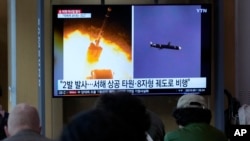North and South Korea say they exchanged warning shots near a disputed area off their west coast, the latest flareup of military tensions on the Korean Peninsula.
South Korea’s military said it fired warning shots at a North Korean merchant ship that crossed the Northern Limit Line (NLL), the de facto Korean sea border, at 3:42 a.m. Monday.
About 90 minutes later, North Korea fired 10 shells from a multiple rocket launcher system in response to a South Korean military vessel that crossed the border, according to a North Korean military statement posted on state media.
Seoul says Monday’s incident occurred near Baengnyeong, a heavily militarized frontline island controlled by South Korea. According to South Korea’s military, the North Korean ship returned northward after the warning.
North Korea has never recognized the NLL and its ships sometimes cross the border, resulting in tense standoffs at sea. In recent weeks, North Korea has also conducted provocative artillery shelling near the sea border.
Prepping for a 'provocation'
Monday, after the incident, South Korea’s military announced it would hold major exercises in the sea off its west coast “in preparation for enemy provocation.”
The exercise, part of wider, annual defense drills, involves South Korean destroyers, frigates, attack helicopters, and fighter jets, according to South Korea’s Ministry of National Defense. The U.S. Air Force will also participate, it added.
"If the enemy provokes us, we will punish them as we have trained. We must protect our territorial waters," said Ryu Hyo-sang, commander of the Second Fleet of South Korea's Navy, who oversees joint naval exercises in the West Sea.
More missile tests, displays of might
Tensions have grown as North Korea has conducted an unprecedented barrage of missile tests this year. There also are concerns the North could soon carry out its seventh nuclear test since 2006.
In response, the United States and its ally, South Korea, have increased displays of military strength and ramped up joint defense exercises that had been scaled back in recent years.
The moves have raised concerns that the two Koreas, still technically in a state of war after their 1950s conflict ended only in a truce, are entering a particularly dangerous phase of their relations.
North and South Korea held historic talks in 2018, leading to several agreements that reduced military tensions in shared border areas. But North Korea, frustrated by the lack of progress in parallel nuclear talks with the United States, soon walked away from both sets of negotiations.
This year, North Korea has tested a record-high 41 ballistic missiles, passed a new law underscoring its status as a nuclear weapons state, and boasted of its ability to conduct strikes with tactical nuclear weapons.
While North Korea appears intent on provoking a sense of crisis, to what end is not clear. According to analysts, Pyongyang has a longstanding strategy of periodically ratcheting up tensions in order to create leverage ahead of negotiations with the United States and its allies.
But North Korea has consistently rejected recent U.S. and South Korean offers of dialogue. In September, North Korean leader Kim Jong Un said there would be “absolutely no denuclearization, no negotiation and no bargaining chip to trade.”
North Korea has many other possible motivations for conducting weapons tests, including developing new capabilities, demonstrating deterrence, and signaling resolve to its own people.









